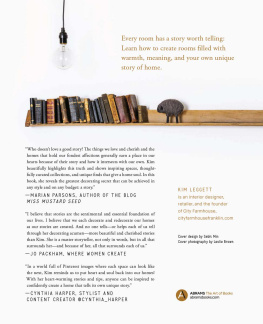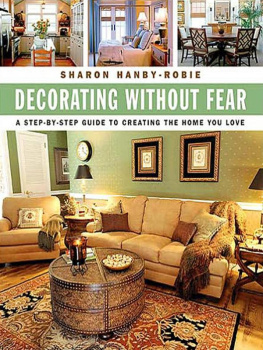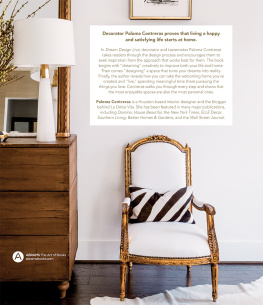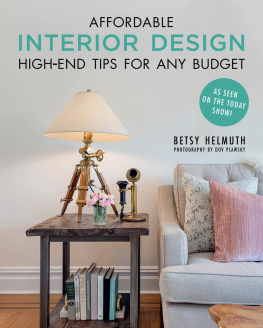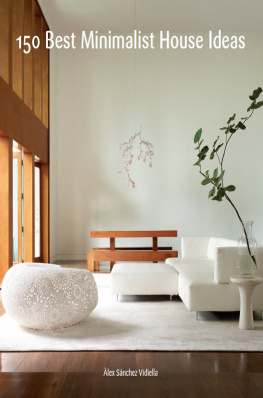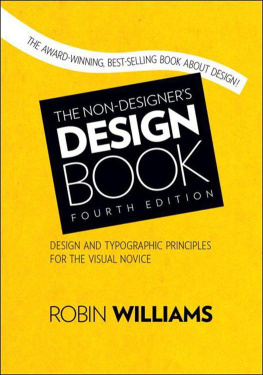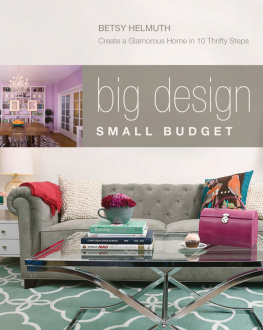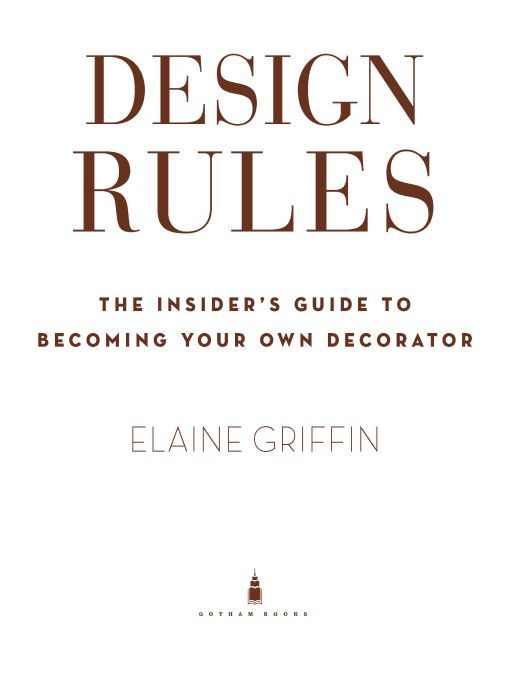Table of Contents
FOR MOM,MYORIGINAL STYLE GURU,
AND MICHAEL, M Y TRUEST INSPIRATION
ACKNOWLEDGMENTS
Fashion fades, but style is eternal! And so are all the maaaah-velous people who helped Design Rules come to be: Janis Donnaud, Agent Extraordinaire; Lucia Watson, the Worlds Most Patient Editor (who will soon be gray overnight because I am the worlds worst procrastinator); Megan Newman, Style Personified; Kathleen Hackett, writing partner de rve; Mim Silverstein, Miss Numbers; John Burgoyne, our own Picasso; and Temo Callahan, whose Studio Printworks Grille Moderne wallpaper has been adapted for use in our interior book design.
Its been more than a decade in design for me now, so Ill add a Texas-style bow (post-deb, at my age, doll, and my knees can barely make it to the floor!) with deepest gratitude to the industry icons for whose support your Designer Girlfriend here is eternally indebted: James P. Druckman, Margaret Russell, Adrian Kahan Leibowitz, Marianne Rohrlich, Karen Carroll and Lydia Somerville, Peter Marino, Scott Salvator and Michael Zabriskie, Samantha Nestor, Irene Wilson, Janice Langrall, O.W., Gayle King, Amy Gross, Suzanne Slesin, and Adam Glassman from the O at Home days, and the hardworking trustees of the Kips Bay Showhouse. Massive, massive smooches to all the editors, vendors, contractors, tradespeople, clients, and assistants who have shared laughter, dcor, and fabulosity with me daily since 1997. Love, endlessly, as always, to Mom and Michael.
XOXO
Elaine
INTRODUCTION
As an established interior designer, I thought, quite frankly, I was the cats meow. I imagined ladies all over the country wistfully longing to engage my services. I just knew they secretly coveted my counsel, wishing for the payday that would allow them to have me come work my mojo on their manses. Who on earth, reasoned I, would want to tackle the thankless task of decorating their own home when they could hire an expert to magically transform it into an Oasis of Paradise in the mere twinkling of an eye? Surely a winning lottery ticket was the only thing keeping us apart.
Darling, how wrong I was! Nothing could have been further from the truth!
Newsflash! American Society of Interior Designers (ASID) polls indicate that most (49 percent!) American homeowners prefer to handle their own decoratingonly 14 percent of them used an interior designers services, whether on a beer or champagne budget.
The more I thought about it, the more sense it all made: You want your home to look like you and nobody else, you take pride in where you live and how faaabulous it looks, nothing feels better than saying, I did it all myself! when its finished, and who wouldnt want to save on all those fees decorators (have to, to be fair) charge?
So I got with the program, picked up a pen, and set out to put to paper some of the practical decorating standards and timeless rules that are second nature to the design professionals who implement them daily, but ones that most folks dont know about. These are the design truths that transcend style, era, and aesthetic; the tips, proportions, and trade secrets that will help you create flowing, balanced, warm, and great-looking rooms that are delights to behold and to be in, whatever decorative style you favor.
Its the secret stuff your decorator would have told you if you were hiring one; the design musts without which you cant successfully do a room but dont want to pay a pro to learn about, either. Theyre the questions that people who do use a designer ask, too. All for the price of the book! Honey, What! A! Bargain!
Ive made it all shamelessly simple (whew!), and packed Design Rules with the information that knowledge-seeking do-it-yourself designers of both sexes shouldnt live without, wherever a sofa meets a chair. If you have an idea of how you want your space to feel when its finished, but arent quiiiiiiiiiite sure how to get there, then, sugar, this is the book for you!
Well go room-by-room throughout your entire house and show you exactly what you need to know in order for everything to flow and be visually successful. Well attack furniture placement, size, and layout; color, lighting, window treatments, painting, flooring, cabinetry, materials, finishes, specific proportions and dimensions, and, of course, accessories, darling! Well cover everything you need to know about decorating... and have a giggle or two while were at it, because as Dorothy Draper once famously said, Decorating Is Fun!
So lets get started.
SPACES YOU LIVE IN
LIVING ROOMS, FAMILY ROOMS, GREAT ROOMS, AND DENS
The living room, family room, great room, and den are the hardest-working spaces of your house. Theyre the rooms you spend the most time in, and they get the greatest wear and tear. Whether you are a studio apartment dweller or are gifted with a sprawling suburban domain, the design rules for the public spaces are the same. Identify the elements that work for your particular space, scale them to suit its size, then thoughtfully devise a floor plan for maximum comfort. Whether you dress them in soothing Zen style or opt for boldly colored decorative drama, theyre high-performance places that need, designwise, to deliver.
THE LAYOUT
When planning where to put your furniture, remember that nine times out of ten, the whole point of seating is for people to sit and talk to each other. Think in terms of conversation groups and not just seating groupschairs should be close enough to the sofa and each other for people to talk comfortably and intimately. Five fabulous seating group setups are shown on the opposite page.
Also take into consideration how you like to live and entertain. Is your home Clubhouse Central for all your friends and family? Then try to accommodate as many people as you sensibly can in your space. Scatter pull-up seating options creatively throughout the room: benches, stools, and odd chairs placed symmetrically against walls (more on this below). At the very least, plan to have seating for a party of four, even if you are an antisocial hermit living in a studio. (Honey, you never know wholl drop by one day!)
Keep in mind that arranging a pair of sofas facing each other looks great in a photo but is always awkward for conversation in real life, because the only time people sit directly across from each other (while not dining) is for formal interviews. Otherwise we turn and talk to the person sitting beside us. If youre doing the two-sofas-plus-a-pair-of-armchairs setup, position the sofas at a right angle to each other and the chairs across from one of the sofas. Thatll work best to create warmth and intimacy in your room.
Its best to find the focal point of a room, and then arrange furniture in a square or a rectangle, either facing or in front of that focal point. What is a focal point, you ask? Its easier to think of orientation rather than focal pointafter all, the furniture is oriented around it, not focused on it. That said, a fireplace is always the focal point of its room. Other good bets for fireplace-less rooms:
In front of a bay window or a plate-glass picture window
Opposite an arched entrance


